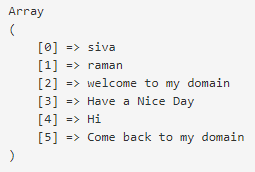Updated April 4, 2023
Introduction to PHP stack
The php stack is defined as the class that will be used for storing the elements in the stack memory. The stack is the sequential set of collections based on a particular property. It can be stored and retrieved by the datas by using the LIFO(last in, first out) property so that the input elements are called the object placed on the stack memory. So the first place of the object is removed from the stack with the help of some default methods. This will be achieved whenever we will insert the elements in the stack using the push() and removed element with the help of the pop() method.
Syntax
In Php stack is the class whenever we want to implement the stack memory in the php; with the help of these classes, we will construct it. By using a constructor, we can create an instance of it. The php stack uses some default methods for storing and retrieving the data from the stack memory. Also, it can be used for some other data structure operations in php.
<?php
class classname {
Access modifier $var;
$var = new Stack();
$var -> push(argument);
$var -> pop(argument);
$var -> default methods for accessing the elements for stack memory;
----some php logics based on the requirement---
}The above codes are the basic syntax for using the stack classes with predefined methods for storing and retrieving the datas from memory.
How does stack work in PHP?
The stack class is mainly used for storing and retrieving the datas from memory. Due to this, the principle and properties like LIFO(last in, first out) can be followed, so the element which is inserted at the last position that is the first element is to be popped out by using the pop() method. So, whenever we want to implement the data structure with the stack concept, these default methods are used for handling these tasks, and they will be related to the database. Generally, the stack is the pile of objects that can be typically arranged with some sort of layers so the stack is the sequential collections with using the particular set of property for each set of values stored or pushed into the stack its created the reference and the same will be removed whenever the stack elements removed from the stack memory.
Every set of values holds its reference, so if we want to push or pop the elements from the stack, it can be implemented with maximum capacity. Hence, if the stack memory is overflow, it is said to be an overflow, i.e.) stack overflow error is thrown; this is for inserting the elements if we use to pop the empty stack thrown the named stack underflow error.
Examples of PHP stack
Below are the different examples of PHP stack:
Example #1
Code:
<?php
$var=array("siva","raman", "welcome to my domain", "Have a Nice Day" );
array_push($var,"Hi","Come back to my domain");
print_r($var);
?>Output:
In the above example, we used the basic array_push() method, which is inherited from the stack class. This push method for inserting the elements in the stack memory. We used the arary_push() method for storing the elements in the array container. It can be started with the index 0 and ends with the specified index the; every string character is to be inserted at the specified position of the memory. It is a sequential storage memory location; if we want to remove the particular element in the array with the help of the pop() method, it will be popped out on the stack memory.
Example #2
Code:
<?php
class Demo
{
protected $vars;
protected $vars1;
public function __construct($vars1 = 47) {
$this->vars = array();
$this->vars1 = $vars1;
}
public function push($eg) {
if(count($this->vars) < $this->vars1) {
array_unshift($this->vars, $eg);
} else {
throw new RuntimeException("Welcome To My Domain");
}
}
public function pop() {
if (empty($this->vars)) {
throw new RuntimeException("Please try user again");
} else
return array_shift($this->vars);
}
}
}
$vars = new Demo();
$vars->push(7);
$vars->push(9);
$vars->push(11);
echo $vars->pop();
$vars->push(7);
$vars->push(9);
$vars->push(8);
echo $vars->pop();
echo $vars->pop();
?>Output:
In the second example, we used stack class in different ways; we can call the default methods like push(), pop() method for inserting and removing the elements from memory. Also, we can use the other methods like the array_shift() method for removing the first element from an array and returns the value of the removed element. All numerical arrays will use the keys will be modified and to start counting the zero values while using literal keys. If the elements are removed, the elements so once we popped out from the stack, the reference variable is also being removed from the memory.
Example #3
Code:
<?php
class Example
{
protected $vars;
protected $vars1;
function __construct($vars1 = 19) {
$this->vars = array();
$this->vars1 = $vars1;
}
function push($eg1) {
if(count($this->vars) < $this->vars1) {
array_unshift($this->vars, $eg1);
} else {
throw new RuntimeException("Welcome To Third example");
}
}
function pop() {
if (empty($this->vars)) {
throw new RuntimeException("Please try user again");
} else {
return array_shift($this->vars);
}
}
function top() {
return current($this->vars);
}
function isEmpty() {
return empty($this->vars);
echo $vars;
}
}
$vars = new Example();
$vars->push(1);
$vars->push(11);
$vars->push(111);
echo $vars->pop();
$vars->push(72);
$vars->push(92);
$vars->push(83);
echo $vars->pop();
echo $vars->pop();
echo "\n \n";
echo "The Stack memory is full \n";
?>Output:
In the above third example, we used the same methods as previous example 2, but here we used other two additional methods like a top() and isEmpty() for checking the array list values from memory. These two default methods will use for validating the arrays size and stack memory by using the LIFO property algorithm; the last element is removed from the memory. By using the array_shit() method, we can traverse and popped out the elements from the last position of the first element.
Conclusion
The stack in php is used to understanding the stack traces, memory to encapsulate the datas in the user prospectives. By using the default methods like push(), pop(), and even other methods for storing the elements in the stack. Once filled, it throws the stack overflow error throws if the elements are to be inserted in the stack memory if suppose we have to remove the element by using pop(), it throws the stack underflow error occurs on the screen.
Recommended Articles
This is a guide to the PHP stack. Here we discuss the introduction, syntax, and working of a stack in PHP along with different examples and outputs. You may also have a look at the following articles to learn more –




